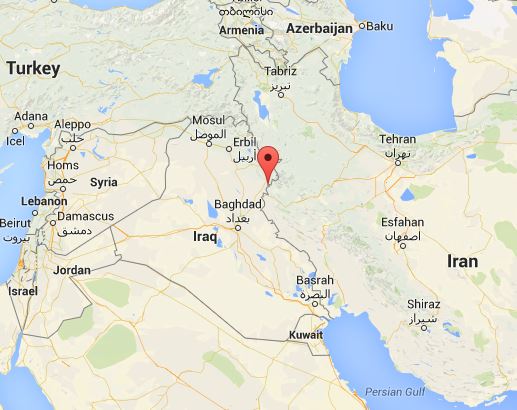I visited one of my relatives who resides at Lake Darbandikhan. It was a holiday. I was chatting with him about the relief of “Horen Shekhan” (Kurdish: هۆرێن و شێخان; Arabic هورين- شيخان) at Darband-i-Belula (Belula Pass). I told him that at the main hall of the Sulaymaniyah Museum, there is a large wall poster of a rock relief; the poster’s caption says that this is the “Relief of Belula Pass.” Where is this rock-relief of Belula Pass is located? He did not know the answer, but his son-in-law said that there is an ancient structure on a mountain at Darband-i-Belula (Kurdish: ده ربندي بيلوله) . “There is a sign on the road, I read it, which says that this the Akkadian relief of Belula Pass, but I have not seen that thing because it lies high up in the mountain,” he added.
Fantastic! I said: “Can you take me there, please, at least I can start from there?” He agreed. This archaeological trip was entirely unplanned but I always take my Nikon gear with me wherever I go!
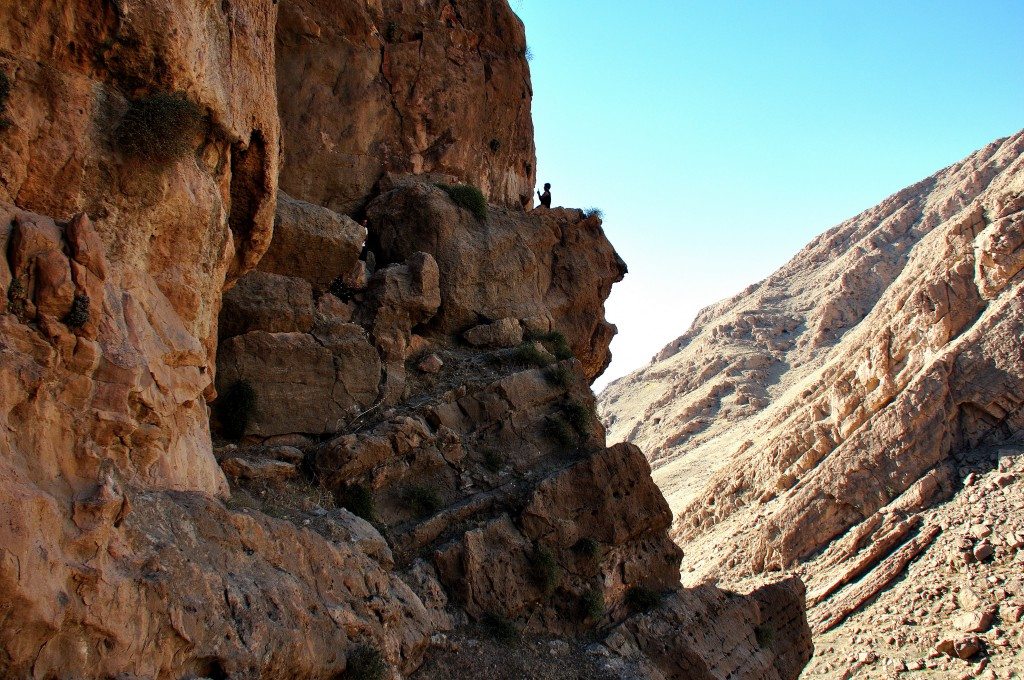
Finally, we have found it! One my friends climbed up, in a very risky situation to sit down before the relief. Note the location of the relief and the very small space in front of it. Photo © Osama S. M. Amin.
At Belula Pass
It was Friday and a very hot day. From Lake Darbandikhan, southwest of the city of Sulaymaniyah, we headed west and then south-west. We asked many villagers about this mountainous relief and they guided us; they know it very well. Finally we found that road sign; it is an old one and reads “The Akkadian relief of Barband-i-Belula.”
But wait, where is it? It is a high and very steep mountain; there is no single clue about where this relief is? We were three people and decided to ascend in three different ways for better hopes of finding it. It was a long climb and search, but at last we found it! The rock-relief of Darband-i-Belula lies on the cliff side of Mount Darband-i-Belula in the Horen Shekhan area, Sulaymaniyah Governorate, Iraqi Kurdistan, near the Iraq-Iran border (34°52’3.61″N, 45°44’2.77″E).
A Long Way Up
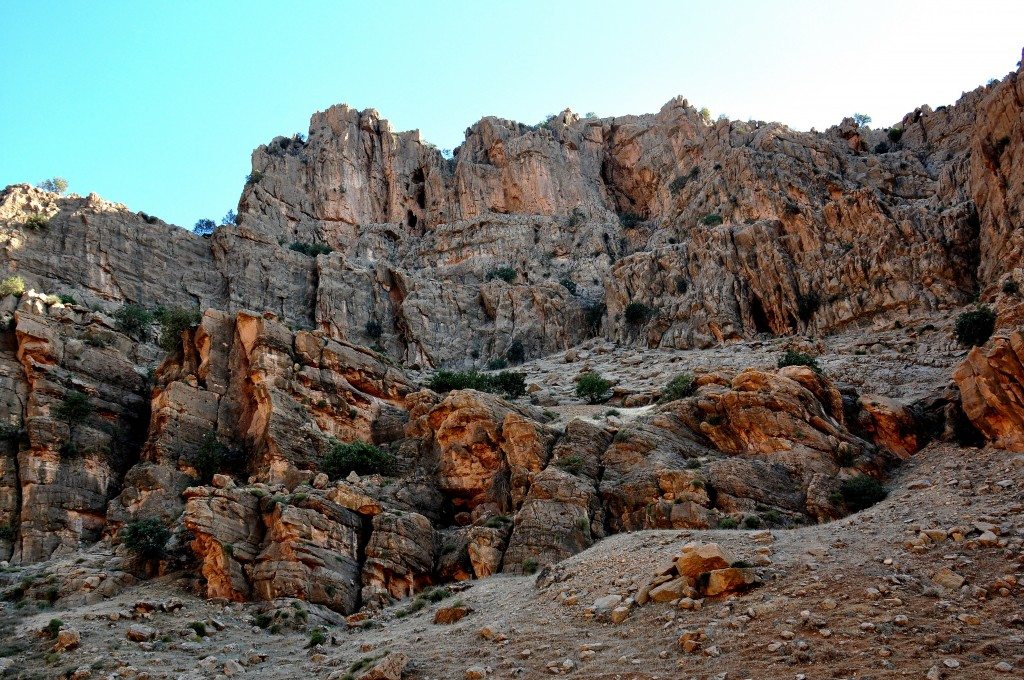
Where is the relief? There is no clue or sign! We are on the way, climbing up the mountain. Photo © Osama S. M. Amin.
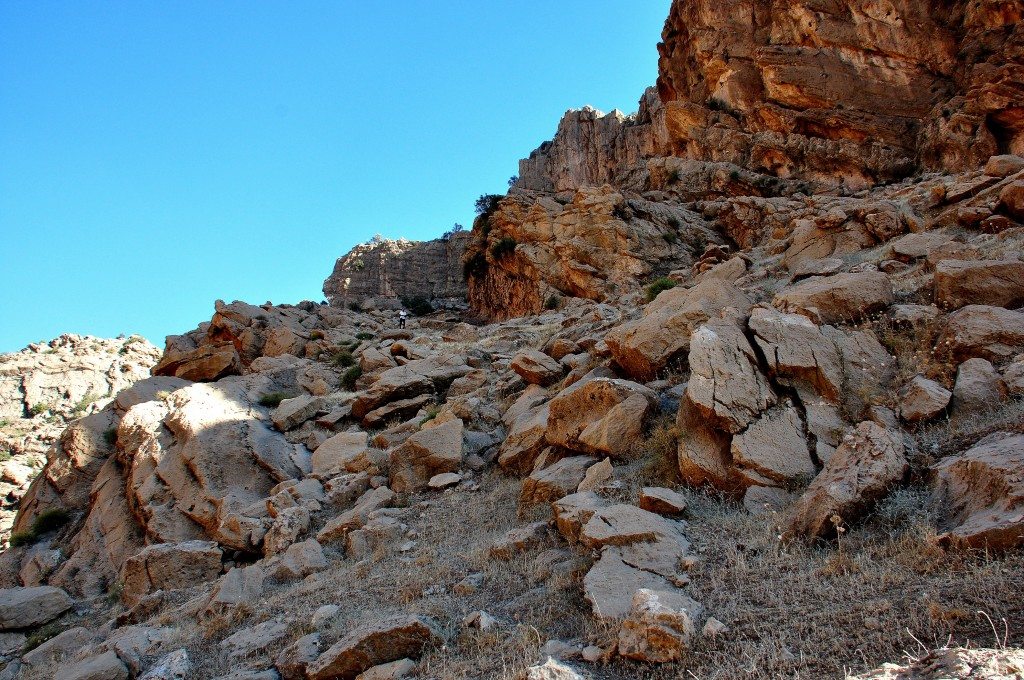
Still, more to go…and we still haven’t found a single clue! My friend appears far away from me. Photo © Osama S. M. Amin.
Found: The Belula Pass Relief!

Finally, there you are! One my friends ascended up, in a very risky situation to sit down before the relief. Note the location of the relief and the very small space in front of it. Photo © Osama S. M. Amin.
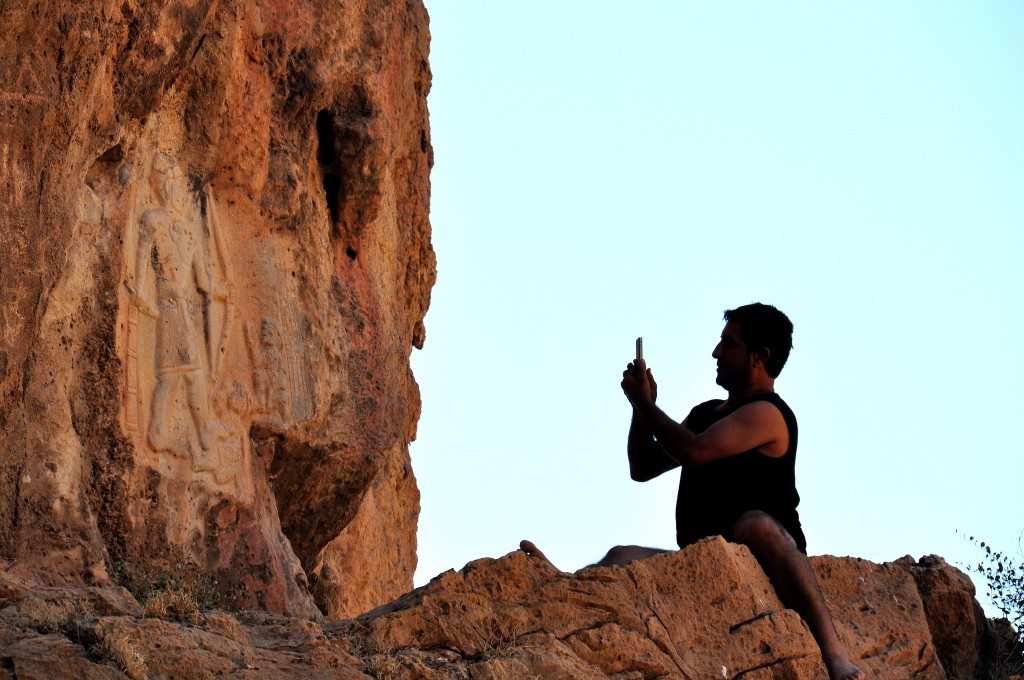
My friend, Mr. Rizgar, sits before the relief and shoots close-up images. Note the small space he sits on. A minor slipping movement would have a disastrous consequences! Photo © Osama S. M. Amin.
The Relief
It is about 1 x 1 meter in diameter. There are three figures in the relief; one victorious warrior (this is the core figure of the relief) and two defeated enemies. The victorious figure stands/strides, looks to his left side, and holds a recurve or triangular bow with his left hand; the bowstring crosses in front of the man’s left elbow joint. The right hand holds what appears to be a small sword or dagger. Besides his right leg and on the earth, there is a quiver holding more arrows. He wears a rolled-up and rounded cap (similar to the ones which were used by the Ur III kings). There is no beard! He is bare-chested and wears a necklace. A perforated disc is attached to his necklace; this disc may represent something.

A zoomed-in image of the relief. Nikon D90 with a AF-S DX NIKKOR 18-300mm f/3.5-5.6G ED VR lens. Photo © Osama S. M. Amin.
The victorious man wears a kilt, which ends shortly above his knees. The waist is narrow and there is a multi-layered belt around the mid-abdomen. There is an axe attached at the waist behind the right side of the belt. He does not seem to wear sandals or any other shoes. The overall depiction of this non-bearded, bare-chested, and bare-footed man reminds us of early Sumerian rulers or warriors.
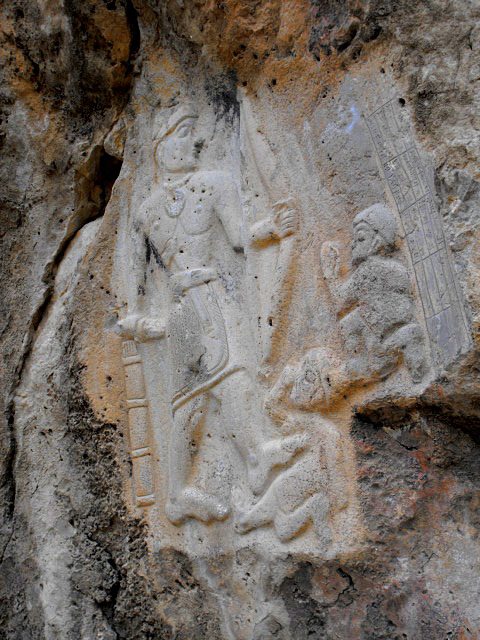
The relief en face. Photo courtesy Mr. Osman Toofiq, Assistant Lecturer, College of Archaeology, Sulaymaniyah University.
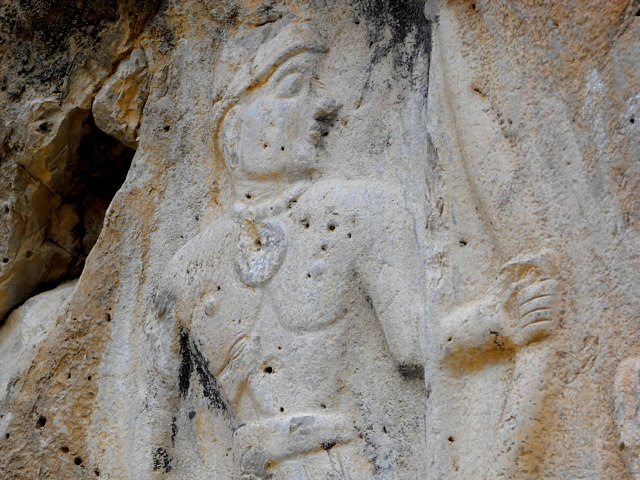
A close-up view of the victorious warrior. Photo courtesy Mr. Osman Toofiq, Assitant Lecturer, College of Archaeology, Sulaymaniyah University.
Before him, there are two captives (enemies). On is sitting on his buttocks on the ground and looks upwards towards the main figure of the relief (warrior). His right leg is extended on the floor while the left leg is flexed. He puts both hands below his pelvis (or, others think that he raises up his left arm, as if he is asking for something, replying to an answer, protecting his face, or covering his eye), wears a short kilt, and is bare-footed. On the head, there is cap. The overall dress and cap are very similar to those which were used by the Hurrian soldiers. His back is leaning against a low wall or bench-like structure. The warrior’s left foot presses against this captive’s abdomen who appears fragile and collapsed.
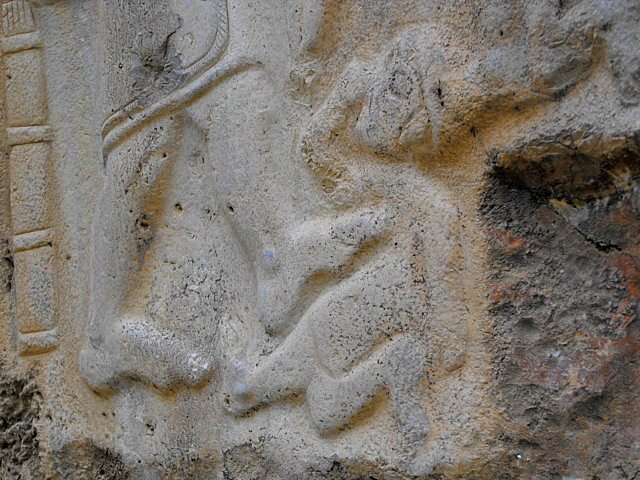
A close-up view of one of the 2 the vanquished enemies, which might be Hurrians. The overall depiction is that of a collapsed person; he might be dead already! Photo courtesy Mr. Osman Toofiq, Assistant Lecturer, College of Archaeology, Sulaymaniyah University.
Behind this captive there is another captive but this one is kneeling or squatting. He puts his left hand on the left knee while he raises up his right arm/hand as if he is beseeching the warrior to spare his life. He wears the same kilt and head cap and is bare-footed. However, some think that the captives’ clothes are not that obvious and both are naked.
At the right margin of the relief, there are four rectangular spaces; each is divided into four long and thin rectangles of Akkadian inscriptions (however the bottom row of rectangular spaces was left blank). A total of 46 cuneiform signs were identified. The overall scene and the style/shape of the inscriptions on the relief date the work back to the Akkadian period, circa 22nd century BCE.
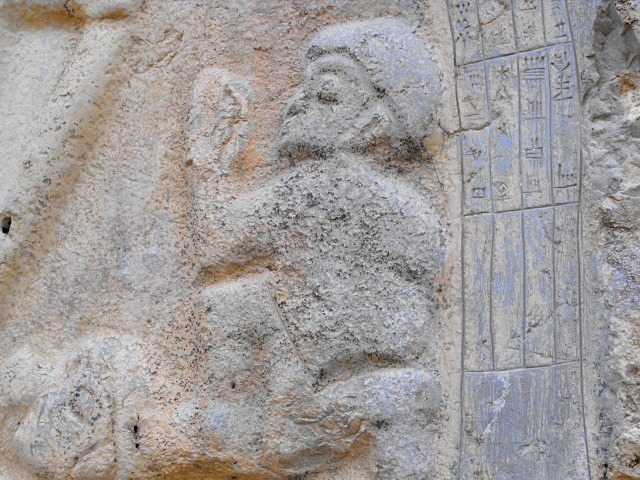
The other captive; he looks as if he is asking for mercy! The helmet and his dress may point towards a Hurrian soldier. The relief en face. Photo courtesy Mr. Osman Toofiq, Assistant Lecturer, College of Archaeology, Sulaymaniyah University.
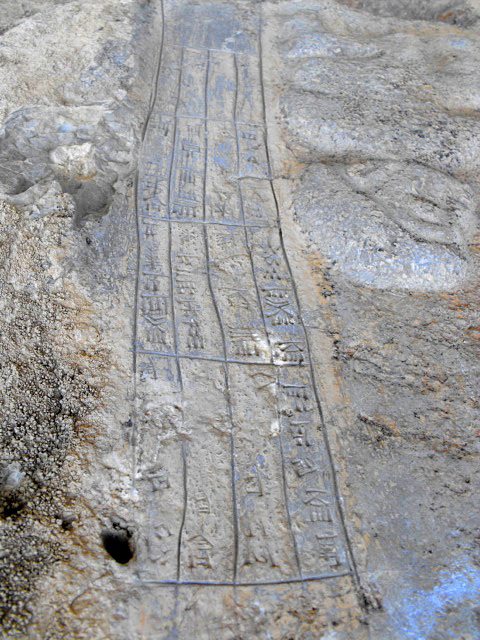
A close-up view of the relief’s inscriptions; the name of “Tar…duni” appears in one of the translations. It is thought that these inscriptions were added to the relief later on. The relief en face. Photo courtesy Mr. Osman Toofiq, Assistant Lecturer, College of Archaeology, Sulaymaniyah University.
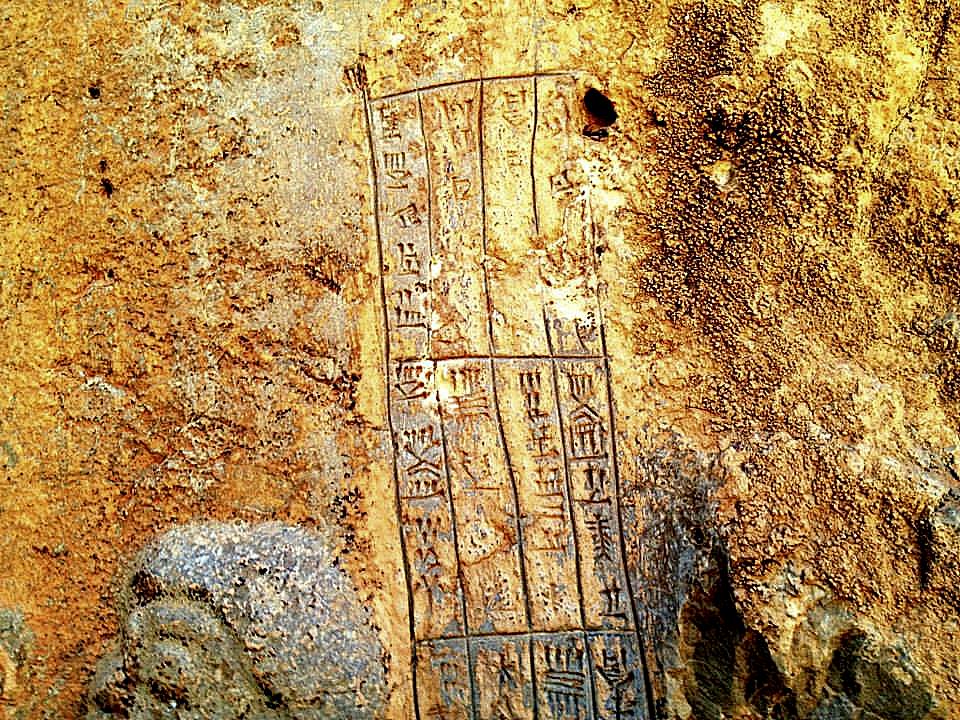
A close-up image of the inscriptions. An iPhone camera was used to capture this image. My friend, Mr. Rizgar, shot it.
The body contours of the main figure of the warrior appear superficial and were not depicted in a highlighted strong body-builder pattern, as in the rock relief of the Akkadian king Naram-Sin at Darband-i-Gawr. However, there are many similarities between the 2 rock reliefs;:
- the overall gesture,
- head cap,
- kilt,
- bow,
- and the defeated enemies.
Mr. Hashim Hama Abdullah, director of the Sulaymaniyah Museum, says that the inscriptions seemed to be added to the relief later on, not at the same time when the relief was made, and there are many readings of these inscriptions; the names of different kings/rulers appear, unfortunately. There is a theory that this represents a Gutian ruler. The most acceptable theory is that the name “Tar…dunni”, son of Ikki, who was a Lullubian king, prince, ruler, or high-ranking official, is the name of the depicted warrior. Did “Tar…dunni” document one of his victories against the Hurrians on this relief? Or, who was the victors and vanquished? Why, when, and where the battle occurred?
Anyway, archeologists were in dispute with respect to how to translate/read the king’s name and his father as well as the rest of the text? The Sulaymaniyah museum scholars read the king’s name as Tar…dunni, Tar…ni, …birini, …irpirin, or …irbirini (the three dots indicate that the cuneiform signs couldn’t be read). However, the name of the king’s father was less confusing and it was read as Ikki, Ikkibshakhmat, or Ikkipshakhmat.
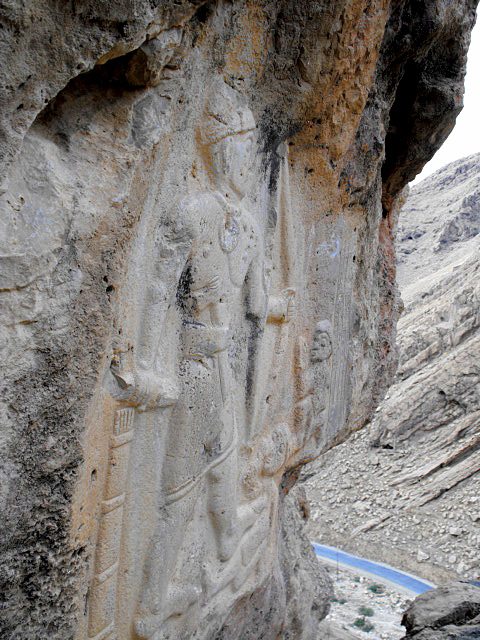
The relief’s location on the mountain’s cliff. Who sculpted this relief here and why he chose this place? The relief en face. Photo courtesy Mr. Osman Toofiq, Assitant Lecturer, College of Archaeology, Sulaymaniyah University.
The relief’s location on the cliff is a strange one; why it was put there? The cliff is relatively sharp and steeply. Who knows how the area was 4000 years ago?
The anonymous sculptor, who witnessed the event, was successful in translating it into this wonderful Akkadian-type of Mesopotamian art. The echoes of the relief can be heard silently between these dead mountains and the scent of history can be easily felt, not smelled! What a thrilling sensation!
Chchchcch…chchchch…chchchchch…the sound of my Nikon’s shutter declined to calm down! I was not able to go up further and to sit down before the relief; my friend (Mr. Rizgar) ascended in response to my request and took the risk! He used his iPhone to capture the “close-up images” of the relief. I zoomed-in with my lens as much as I could to photograph the relief and document his ascent!
This is the first article on this relief on the internet and the pictures you see are equally the first ones ever published online. I surfed the net and Googled many terms in order to get as much information about this relief as I can. But I failed. The pertinent literature (in English) provided me virtually next to nothing and the Arabic ones contained only few sentences while the Kurdish literature provided one PDF in Kurdish language by Mr. Fadhil Qaradaghi. I hope that I was successful in conveying this unknown, yet very important, relief to the rest of the world and that I have opened the door to scholars, researchers, and archaeology students to uncover more information about it.
I’m very grateful to my friends Mr. Rizgar Hama, Mr. Dana Hiwa, and Mr. Mahmood Rajab for their kind help during the trip. Many thanks go to Mr. Hashim Hama Abdullah, director of the Sulaymaniayh Museum, for the very helpful information he provided me with, including the scanned sketch of the relief. A special gratitude goes Mr. Osman Toofiq, Assistant Lecturer at the College of Archaeology, Sulaymaniyah University who provided me with close-up images of the relief (the pics were shot with a Fujifilm Finepix S1000fd camera in 2010 and I edited them using Picasa).
Let’s descend and go back! Next, I will uncover the dangerous journey of the stela of Iddi(n)-sin, king of Simurrum.
Related Photos

One of the halls of the Sulaymaniyah Museum, Sulaymaniyah Governorate, Iraqi Kurdistan. The large wall poster on the left side of the viewer (behind the stela of Iddi-Sin, king of Simurrum) depicts the Akkadian relief of Darband-i-Belula. Photo © Osama S. M. Amin.
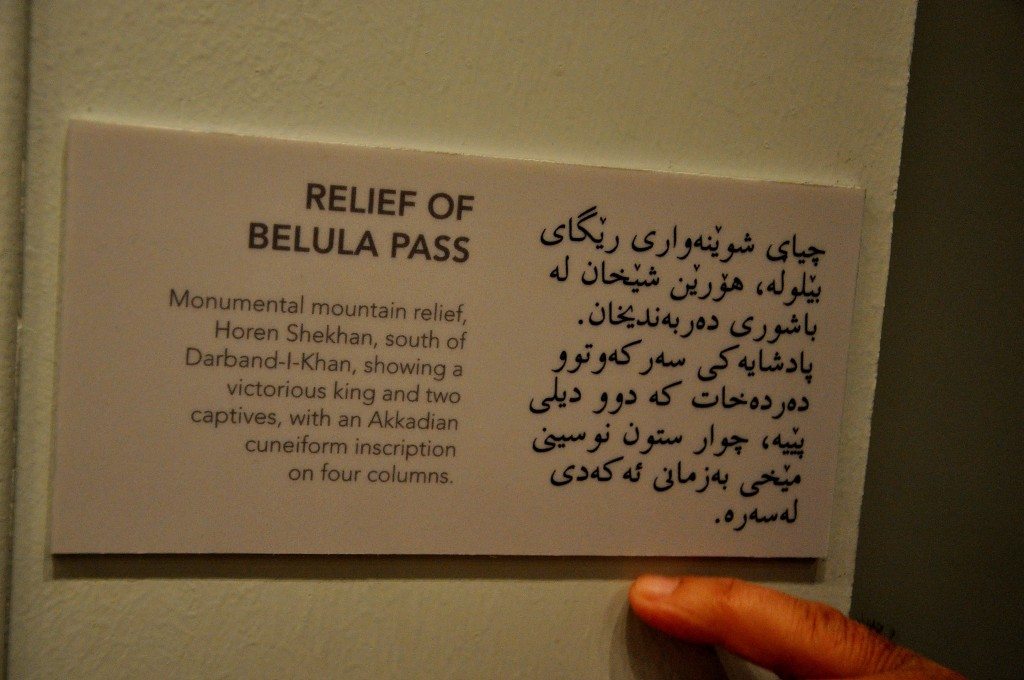
The description of the wall poster in English and Kurdish languages next to the wall poster at the Sulaymaniyah Museum. Photo © Osama S. M. Amin.
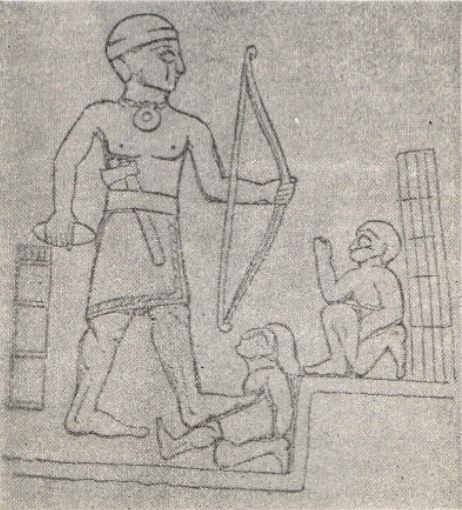
A sketch of the relief, which was scanned from the book of Taha Bakir and Fouad Safr “المرشد الى مواطن الاثار و الحضارة, الرحلة السادسة, بغداد-حلبجة.” 1966

